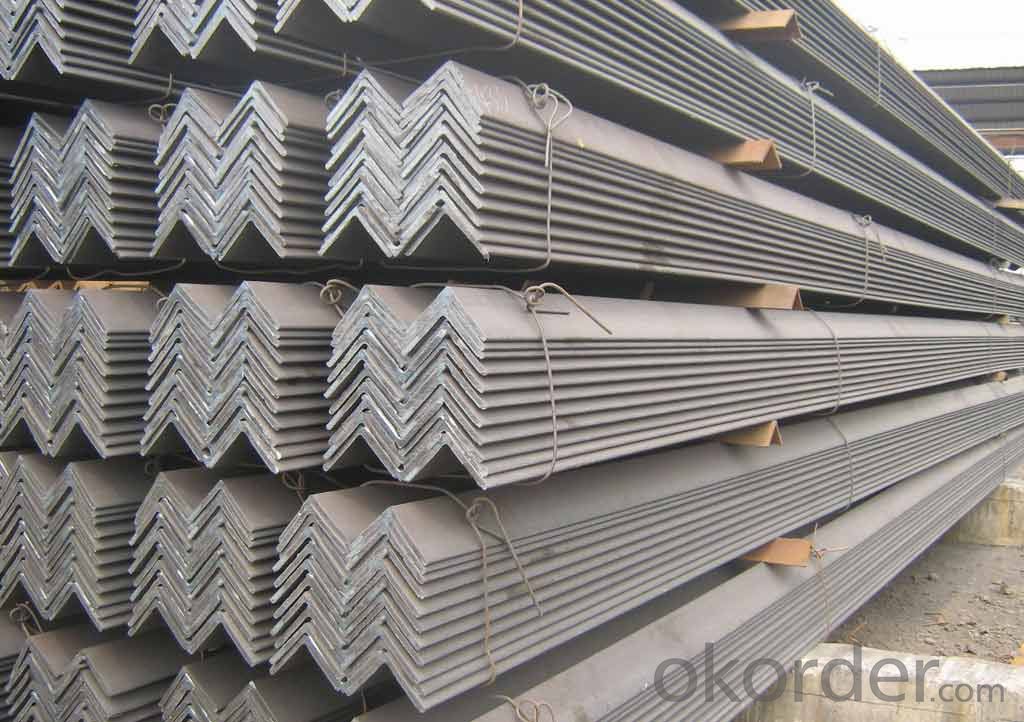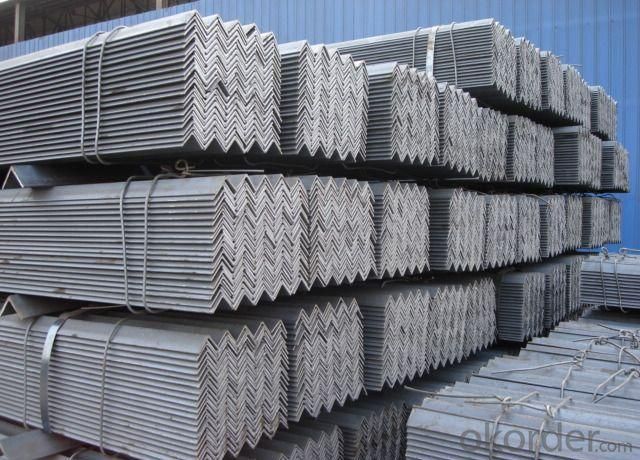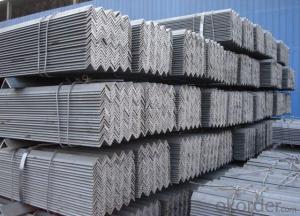Hot Rolled Steel Angle Bar with High Quality
- Loading Port:
- Tianjin
- Payment Terms:
- TT OR LC
- Min Order Qty:
- 25 m.t
- Supply Capability:
- 10000 m.t/month
OKorder Service Pledge
OKorder Financial Service
You Might Also Like
Products Description
Specifications of Equal Angle Steel
1.Standards:GB
2.Length:6m, 12m
3.Material:GBQ235 or Equivalent
4. Size:
Size (mm) | Mass (mm) | Size (mm) | Mass (mm) |
| 40*40*3 | 1.852 | 45*45*5 | 3.369 |
| 40*40*4 | 2.422 | 50*50*4 | 3.059 |
| 40*40*5 | 2.976 | 50*50*5 | 3.77 |
| 45*45*4 | 2.736 | 50*50*6 | 4.465 |
Usage & Applications of Equal Anlge Steel
Trusses;
Transmission towers;
Telecommunication towers;
Bracing for general structures;
Stiffeners in structural use.
Packaging & Delivery of Equal Angle Steel
1. Transportation: the goods are delivered by truck from mill to loading port, the maximum quantity can be loaded is around 40MTs by each truck. If the order quantity cannot reach the full truck loaded, the transportation cost per ton will be little higher than full load.
2. With bundles and load in 20 feet/40 feet container, or by bulk cargo, also we could do as customer's request.
3. Marks:
Color mark: There will be color marking on both end of the bundle for the cargo delivered by bulk vessel. That makes it easily to distinguish at the destination port.
Tag mark: There will be tag mark tied up on the bundles. The information usually including supplier logo and name, product name, made in China, shipping marks and other information request by the customer.
If loading by container the marking is not needed, but we will prepare it as customer request.
FAQ:
Q1: Why buy Materials & Equipment from OKorder.com?
A1: All products offered byOKorder.com are carefully selected from China's most reliable manufacturing enterprises. Through its ISO certifications, OKorder.com adheres to the highest standards and a commitment to supply chain safety and customer satisfaction.
Q2: How do we guarantee the quality of our products?
A2: We have established an advanced quality management system which conducts strict quality tests at every step, from raw materials to the final product. At the same time, we provide extensive follow-up service assurances as required.
Q3: How soon can we receive the product after purchase?
A3: Within three days of placing an order, we will arrange production. The shipping date is dependent upon the quatity, how many sizes you want and the plan of production, but is typically 30 to 45 days from the beginning of production.
Images:


*If you would like to get our price, please inform us the size, standard/material and quantity. Thank you very much for your attention.
- Q:Can steel angles be bolted together?
- Yes, steel angles can be bolted together. Steel angles are often used in construction and fabrication projects, and one common method of joining them is by using bolts. Bolting steel angles together provides a strong and secure connection that can withstand heavy loads and forces. The angles are typically drilled with holes at specific intervals, and bolts are inserted through these holes and tightened with nuts to hold the angles together. This method allows for easy disassembly and reassembly if needed, making it a versatile and practical choice for joining steel angles.
- Q:Can steel angles be used in the construction of sports stadiums?
- Yes, steel angles can be used in the construction of sports stadiums. Steel angles are commonly used as structural components in various construction applications, including sports stadiums. They provide strength, support, and stability to the overall structure, making them a suitable choice for constructing large-scale venues like sports stadiums.
- Q:What is the maximum length for a curved steel angle?
- The maximum length for a curved steel angle depends on several factors, including the diameter of the curve, the thickness of the steel, and the specific requirements of the project or application. In general, the length of a curved steel angle can vary from a few inches to several feet. However, it is important to consult with a structural engineer or a manufacturer to determine the maximum length that can be achieved without compromising the structural integrity of the angle. Additionally, the manufacturing process and equipment available may also play a role in determining the maximum length achievable for a curved steel angle.
- Q:How are steel angles cut to specific lengths?
- To achieve specific lengths, various cutting tools and techniques are employed for steel angles. Among these, a common approach involves the use of saws, such as band saws or circular saws with metal-cutting blades. By securely clamping or holding the angle in place, a precise and clean cut can be made as the saw blade is guided along the desired cutting line. Alternatively, an abrasive cutting wheel, also known as a cutoff wheel or grinding disc, can be utilized. This method is particularly suitable for thinner steel angles or situations requiring a more accurate cut. By securing the angle in a vise or similar holding device, the cutting wheel is cautiously guided along the marked cutting line, removing excess material. For larger and thicker steel angles, plasma cutters or oxy-fuel torches are viable options. Both methods involve elevating the steel's temperature to a point where it either melts or oxidizes, enabling a meticulous and precise cut. Plasma cutters utilize a focused jet of ionized gas, while oxy-fuel torches employ a combination of oxygen and a fuel gas, like acetylene or propane. In certain cases, more specialized techniques such as water jet cutting or laser cutting can be utilized to cut steel angles. Water jet cutting employs a high-pressure stream of water mixed with abrasive particles to erode the steel, while laser cutting relies on a concentrated laser beam to melt or vaporize the material along the intended cutting path. Regardless of the chosen method, it is crucial to firmly secure the angle in place and accurately guide the cutting tool along the marked cutting line. When cutting steel angles to specific lengths, it is important to prioritize safety by taking appropriate precautions like wearing protective eyewear and gloves.
- Q:How do you join steel angles together?
- One common method to join steel angles together is by using welding techniques. This involves heating the joint area to a high temperature and fusing the angles together using a welding electrode or filler material. Welding creates a strong and durable bond between the steel angles, ensuring structural integrity.
- Q:Are steel angles affected by temperature changes?
- Temperature changes have an impact on steel angles. Similar to all substances, steel undergoes expansion upon heating and contraction upon cooling. These alterations in size can result in dimensional variations in steel angles, thereby potentially compromising their structural stability and fit. Therefore, it is crucial to consider the temperature range that steel angles will encounter in their designated use and accommodate these modifications during the design and installation processes. Furthermore, significant fluctuations in temperature can also influence the mechanical characteristics of steel, including strength and ductility. Consequently, it is essential to factor in these aspects when choosing the most suitable steel angle for a particular application.
- Q:What are the common corrosion protection methods for steel angles?
- There are several common corrosion protection methods for steel angles. These methods aim to prevent or slow down the process of corrosion, which occurs when steel is exposed to moisture or certain chemicals in its environment. Here are some of the most widely used corrosion protection methods for steel angles: 1. Galvanization: This is a popular method that involves coating the steel angle with a layer of zinc. The zinc acts as a sacrificial anode, meaning it corrodes instead of the steel when exposed to moisture or chemicals. Galvanization provides excellent protection against corrosion and can significantly extend the lifespan of steel angles. 2. Painting: Applying a coat of paint to the steel angle can act as a barrier between the metal and its environment, preventing moisture and chemicals from reaching the surface. However, it is important to choose the right type of paint that is specifically designed for corrosion protection and to ensure proper surface preparation before painting. 3. Powder coating: This method involves applying a dry powder to the steel angle, which is then heated and cured to create a durable and protective coating. Powder coating provides excellent corrosion resistance and is often used in outdoor applications. 4. Epoxy coating: Epoxy coatings are commonly used in corrosive environments such as chemical plants or marine applications. These coatings are highly resistant to chemicals and provide a protective barrier against corrosion. 5. Cathodic protection: This method involves making the steel angle the cathode in a galvanic cell, where a sacrificial anode is connected to the steel angle. This creates an electrochemical reaction that prevents corrosion. Cathodic protection is often used in structures such as underground pipelines or offshore platforms. It is important to note that the choice of corrosion protection method depends on various factors such as the specific environment in which the steel angles will be used, the expected service life, and the budget. Consulting with corrosion protection experts or engineers can help determine the most suitable method for a particular application.
- Q:Are there any industry standards or codes for steel angles?
- Yes, there are industry standards and codes for steel angles. These standards and codes are developed by various organizations and bodies in the steel industry to ensure the quality, safety, and reliability of steel angles used in various applications. One of the most widely recognized standards for steel angles is the American Society for Testing and Materials (ASTM) A36 standard, which specifies the requirements for carbon structural steel shapes, including angles. This standard covers the chemical composition, mechanical properties, and dimensional tolerances of steel angles. Additionally, there are other standards and codes developed by organizations such as the American Institute of Steel Construction (AISC), British Standards Institution (BSI), and European Committee for Standardization (CEN), among others, that provide guidelines and specifications for steel angles used in specific industries or regions. These industry standards and codes play a crucial role in ensuring the consistent quality and performance of steel angles, promoting safety, and facilitating effective communication between manufacturers, designers, and end-users.
- Q:Are steel angles resistant to pests and insects?
- Yes, steel angles are resistant to pests and insects as they are not a food source and provide no habitat for them.
- Q:How are steel angles installed on concrete structures?
- To reinforce and support concrete structures, steel angles are commonly utilized. The installation of steel angles on concrete structures entails several steps. To begin, the concrete surface must be prepared. This entails thoroughly cleaning the surface and eliminating any debris or loose material. The concrete must be in good condition, devoid of cracks or other structural problems. Next, the steel angles must be positioned and marked on the concrete surface. Typically, a measuring tape and chalk line are used for this purpose. Based on the structural requirements, the angles are usually placed at specific intervals and locations. Once the positions have been marked, the concrete surface needs to be drilled. This is accomplished using a drill and a masonry bit appropriate for the size of the anchor bolts or fasteners that will be employed. It is crucial to drill the holes to the required depth to ensure a secure and stable installation. After the holes have been drilled, anchor bolts or fasteners are inserted into them. These bolts or fasteners are specifically designed for securely fastening steel angles to concrete surfaces. Usually made of steel, they possess a threaded end that enables them to be firmly tightened into the concrete. Once the anchor bolts or fasteners have been inserted, the steel angles are positioned and aligned with the marked locations on the concrete surface. The angles are then secured to the concrete by tightening the nuts on the anchor bolts or fasteners. Finally, the installation is examined for accuracy and stability. The angles should be securely attached to the concrete surface and should not move or shift when pressure is applied. Additional adjustments or tightening may be necessary to ensure a dependable and secure installation. All in all, the process of installing steel angles on concrete structures involves meticulous preparation, drilling, anchoring, and securing. This guarantees that the angles deliver the necessary strength and support required for the specific application.
1. Manufacturer Overview |
|
|---|---|
| Location | |
| Year Established | |
| Annual Output Value | |
| Main Markets | |
| Company Certifications | |
2. Manufacturer Certificates |
|
|---|---|
| a) Certification Name | |
| Range | |
| Reference | |
| Validity Period | |
3. Manufacturer Capability |
|
|---|---|
| a)Trade Capacity | |
| Nearest Port | |
| Export Percentage | |
| No.of Employees in Trade Department | |
| Language Spoken: | |
| b)Factory Information | |
| Factory Size: | |
| No. of Production Lines | |
| Contract Manufacturing | |
| Product Price Range | |
Send your message to us
Hot Rolled Steel Angle Bar with High Quality
- Loading Port:
- Tianjin
- Payment Terms:
- TT OR LC
- Min Order Qty:
- 25 m.t
- Supply Capability:
- 10000 m.t/month
OKorder Service Pledge
OKorder Financial Service
Similar products
New products
Hot products




























